Rendering Pork Fat to make Leaf Lard for Pie Pastry
When I rendered my own cooking lard a couple of weeks ago, I was surprised by the reaction of some readers. Rendering one’s own fat was “way out there”. I wanted to do a pork belly confit and wouldn’t think of doing it with pastry lard. Rendering my own was the only way to go. I have done it before, but not on such a large scale. I never use margarine. I use butter and olive oil and now, self-rendered lard. I try to make everything I can from scratch including mayonnaise and salad dressings. Both are so easy and eat up a grocery budget as well as one’s insides. I can’t always so it, but I try. If I haven’t homemade bread, we will buy buns, but I do really work to make my kitchen a sustainable from scratch work place that creates healthy, delicious nutritious and mainly economical meals. I have no problem splurging, either. But, feel it is essential to know what things cost, what they should cost, usually cost, and what I am paying to run my household as well as the nutritional value in the food I place on our table at meal times.
Alan Irvine sells Berkshire boar fat for $0.50 a pound as long as you order it ahead, at almost every local market around Edmonton. The lard I rendered for cooking comes off of the back and sides of the pig. This fat comes from around the kidneys and loin of the pig and is called leaf lard fat. I learned this from Kevin Kossowan. Alan learned it from Kevin, too. I haven’t used my leaf lard for pastry yet, but when I do, I plan to make pastry with mine and with Kevin’s. Then we will compare our pastries with the Tenderflake brand (we will make one using it, too). That will have to wait until Kevin renders his. It will be a great learning experience and a fun taste test, me thinks! (Yes, that is 50 cents a pound.)
The other piece was a shade smaller than this one. I had about 5 pounds of fat. I should have been more specific and asked for 10 pounds. I had only asked if he could get me some. When you do it, you want to do a lot. It isn’t all that messy, but it takes the same amount of time to do twice as much, so I “should have” had twice as much. (Note to self, and to you.)
I did exactly the same thing as I did when rendering pork fat for cooking: cut it into pieces and fried it on medium to medium high heat, stirring constantly until the liquid fat covers the bottom.
Once there is a good layer of liquid fat on the bottom of the pan, the fat pieces will no longer stick to it. You do not want them to stick to the pan our your product will have brown specks in it.
Keep stirring. When fried, you can see this leaf lard fat is actually a different texture and the cubes curl into different shapes than the cooking lard fat. Who knew that when rendering pork fat there are two kinds of fat to render. The leaf lard fat creates a much finer, flavourless lard sought after for making the flakiest of pastries.
At this point, you no longer need to stir, but don’t go far away. Turn the heat to medium so that nothing burns and stay within eyesight so that your pieces do not go too brown. You want nice light white lard.
This looks good. Vanja wasn’t home and he said I could have let it go a couple of minutes longer, until each fatty bit is crisp. Some where a little soggy. But, this is good unless you want to eat the crispy little bits of Crapola left in the pan! (and I think someone did want to!)
So interesting: one batch was quite stinky while the other was not. The stinky package was cooked the same way, but is much darker. It was the one in the blue pan. I do not understand why. Someone has said maybe the leaf lard came from a male pig.
I used mini loaf pans to shape my lard bricks. Use plastic wrap or parchment paper to completely covering the pan as mine didn’t “pop” out. What was I thinking? Sometimes I wonder about myself. In any case, you can see I realized four 2 cup bricks and one 3/4 cup brick from my 5 pounds of rendered pork fat for #2.80. I know exactly what is in it and when it was made. Can’t beat that. It took me about 40 minutes from start to finish.
The following day Vanja scraped the bars out of the pan for me. Aren’t they masterful? I feel so proud accomplishing the smallest of domestic tasks! And, all four were the same “white”: two weren’t darker as the oil from them was when poured into the molds. That was odd.
They are all wrapped up and waiting to be baked into a Saskatoon pie! I haven’t used any Saskatoons that were frozen from our garden this summer. Time to think about that!
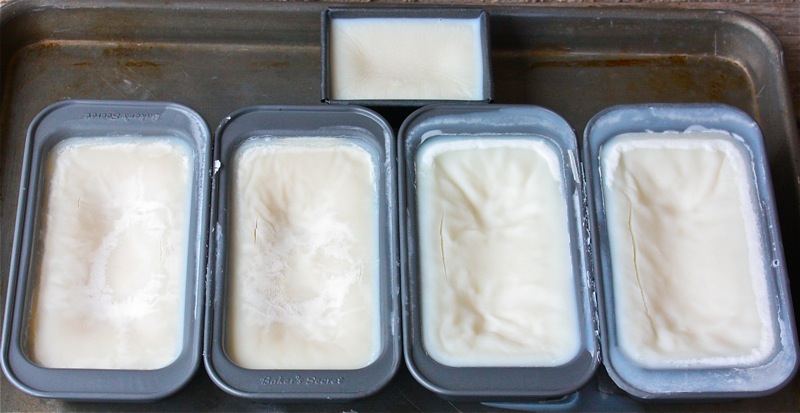



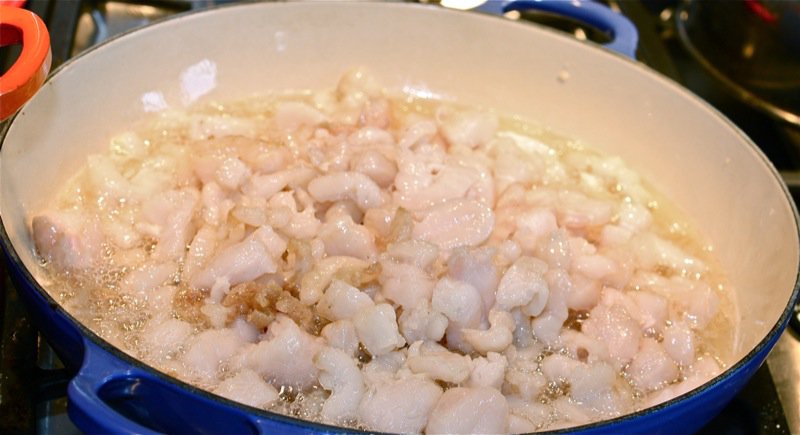




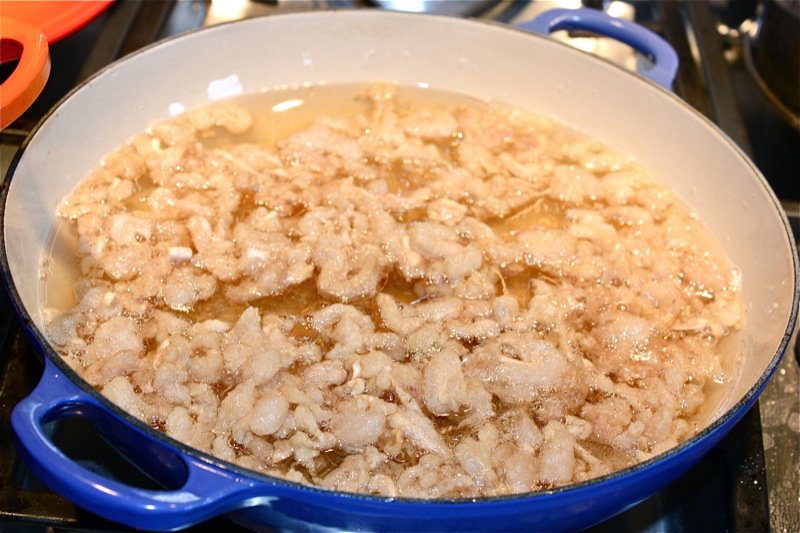






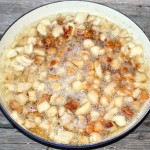

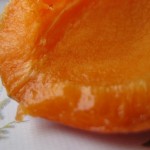





That is amazing. Who would have thought it mattered where the fat came from! It seems so involved, and it is, but pretty quick nonetheless.
That IS quite odd that the two which were darker before solidifying turned out to be the same whiteness as the lighter ones. I wonder what the explanation for that was. And they did turn out quite beautiful. I never thought I’d be saying that pork fat is beautiful, but you’ve opened my eyes. If I didn’t know it was pork fat, I would’ve thought it was soap, or even a nice silky piece of white chocolate…teehee.
In Austria we call the crispy bits “Grammeln”. And it’s being served as dumplings in country side restaurants.
I find the variability interesting. Animals certainly do differ one from the other, and this is a good reminder of that. Could have been feed, the young pigs may have come to Alan from different sources, one may have been boar and one sow, they could have been handled differently at slaughter – who knows!!
Tell me that isn’t a bargain for local cooking fat!!! Your cost is WAY lower than mine when buying the whole animal, so rejoice!
Hey Valerie, I don’t think it’s ‘way out there’, and that’s coming from someone who doesn’t eat pork (smile). I mean, no matter what we eat, we should know its source and ask questions like ‘is it truly grown healthfully for people, animal, and land?’. I think it’s way out there that people don’t ask these questions or seem to care. And they are putting all of this stuff in their mouths;-)!!!
Anyway, I think it’s awesome. Also, where I’m from in the south, rendering one’s one pork lard used to be the only ‘legit’ way to bake a pie or make pastry!
You are an inspiration 🙂
i grew up in portugal and the crispy bits (we call it “torresmos”)are very popular snacks, but it never crossed my mind to make lard with it…. living and learning 🙂
have a wonderful weekend.
n
Valére, you are a much more daring cook than I am. How awesome of you to make your own lard. I bet your pastries would taste amazing with it.
Nisrine
That’s pretty cool! I wish I could get my hands on that pork fat and make a Ukrainian “salo” which is basically a smoked pork fat – my dad would be so happy!
I can relate and admire your persistence in seeking out the best! here in Lebanon we use sheep fat from the tail; these are fat-tailed sheep that dont exist in the US; the fat is sold in every butcher shop. also use lamb fat that is confit for the winter. anyway, it does make a huge difference what kind of fat one uses , in terms of flavor and texture of the pastry.
I like to make things froms scratch too, although it’s more for the fun of it =) Because otherwise, we use a lot of packaged foods in our household! haha….We never actually used butter until I started baking with it a couple of years ago!! My parents always bought margarine because of the lower cholesterol levels =S My mum makes pork fat sometimes though, so I don’t find it unusual =) She learnt from her mother who used to make it all the time- because when she was young, pork fat was the only type of fat which they used- it was the cheapest option! Apparently, eating pork fat with plain rice was really yummy….haha- although my mum won’t let me try =S
I actually didn’t know you could buy lard until the beginning of this year when I saw it at the supermarket! The one I bought was really different to the homemade type though….and it was really stinky too!
I love that you made it in pans!! When I first saw the pictures of it out of the pans, I thought they were the commercially packaged ones =S I can’t wait to see what you do with this!I’ve never heard of Saskatoon pie before =)
Thanks for telling me a bit about your family =) It’s so interesting! To look on the bright side, at least your daughters never left any evidence of their cooking- my mum always gets frustrating at having to clean up the mess I made!! haha…..
My mom used to do that…but not any more…I find the storebought pork fat are kinda smelly…well, all the pork products here in Germany stink…more or less. I will have to poach the pork a couple of times before using.
What is a “Saskatoon pie”? Do you always use pork fat in the baking?
I have to agree with some of your readers: rendering your own fat is definitely hardcore! I get raised eyebrows just for making my own bread, so I can only imagine people’s reactions to your amazing feat! Thanks for sharing the info.
Never used pork fat in baking or any of my dishes before. But making it by yourself sounds great! Everything homemade is better:)
I will be doing this. I rendered duck fat and have 2 litres that is wonderful to use. The process looks almost identical. The little bit left over are cracklings and great sprinkled on a salad.
The loaf pans are such a good idea. I wish I had thought of that when I rendered fat last month. The jars are awkward for freezing.
I have rendered pork fat, and I definitely ate the crisp cracklings! I also rendered suet last year and will never do that again, as the smell was truly unpleasant. Great tutorial and reminder how cheap and simple it is to make your own.
In Chinese community, we just ask the butcher to give us the fat (for free). Than we wash it, dice it and cook it. I make around 32oz per time and it last me a long time. Fried vegetable with it (1 tsp) cook everything from it.
MsChok!
How wonderful that your butcher gives you his fat for free! Love that!
🙂
Valerie
Just wondering, do you how long does the lard last?
How did your pie turn out?
I was thinking about using the lard for the bread. We use shortening for many things like flour tortillas, but I want to avoid the hydrogenated kind, so maybe I should try the lard instead.
HI, Alicia
Lard lasts pretty much forever – esp in a cold place…well, it can go rancid if contaminated, but if it is pure lard in a clean, sealed container, it will last indefinitely.
But, lard in bread is new to me… We just use flour, water, yeast and salt…but, whatever you would normally use a fat in, the lard could be used.
🙂
Valerie
well thank you I have been looking at ways to use my rendered pork & chicken fats , I wanted to make pastry as an alternative , reading your article was a god send for inspiration , as I roast , bake in fats [ just a little for flavour ] , was curious about pastries , now thanks to your article I shall try these pastries , cheers rob
Thirlled, Rob!
Let us know how it goes!
Most pig farmers from the market will get the right fat for you.
🙂
V